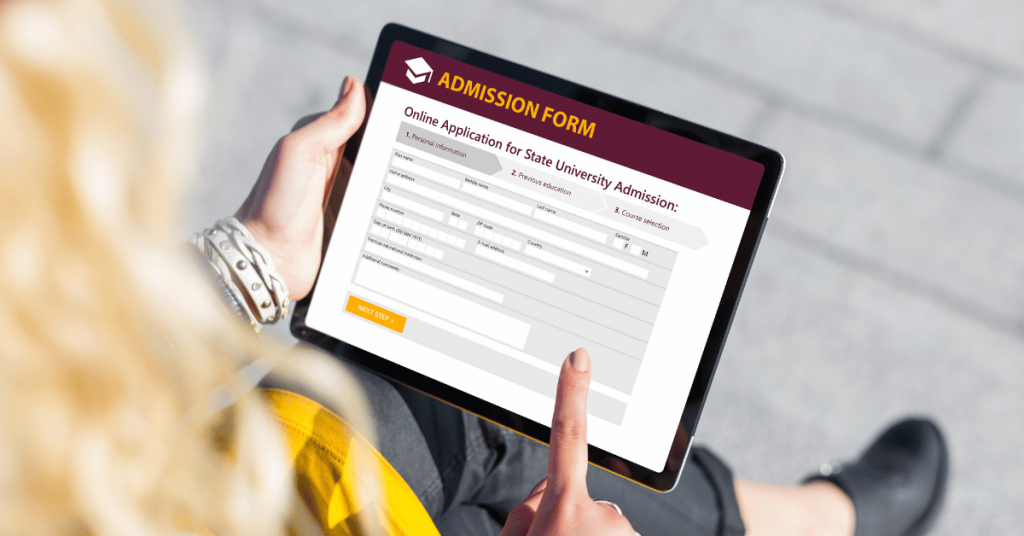Are you an Indian student dreaming of studying in the USA? Are you feeling overwhelmed by the tricky and confusing college application process?
If so, you’re not alone!
Getting accepted into US Universities can be challenging, especially for students from other countries. But if you have the proper guidance and preparation, you can successfully apply to and register at the college of your dreams.
We’ll go through each phase of the US college application process in this article, along with some advice and tactics for making your application stand out. We can assist you with everything from standardised testing to college essays.
Step 1: Research the Universities and Programmes

Do you have these concerns before choosing to attend a US university? If not, then these should be:
- Why do you wish to pursue your education in America?
- Where do you feel most at home?
- Which schools will satisfy your needs in terms of higher education?
- Will you require financial support?
- What are the deadlines for financial aid and applications?
- Where in the USA do you wish to call home?
Focusing on your qualities and authenticity is crucial when applying to a US institution. You should also do your research on the school to demonstrate your enthusiasm. Seek feedback from others to improve your application materials. However, this process takes time and concentration as each application differs and involves collecting recommendations, writing essays, and other requirements. You should start the process at least 12 months prior to the college application deadline and have a backup plan.
To begin, make a list of schools and universities in the USA that offer your preferred program of study and browse their official websites for program information. Contact each school for an application form and international student admission information.
Step 2: Contact the Universities in the USA

Once you have compiled a list of the US schools and universities you wish to attend, the next step is to contact each institution via phone or mail. This is a key time when you may get any questions or concerns about the particular university’s courses, programs, teaching style, lodging, costs, application procedure, and information on admission for international students answered.
Step 3: Review Application Essentials and Requirements

The next stage is to compile all the information and prerequisites for the application process after making a list of prospective colleges and universities.
Understanding the eligibility requirements, gathering the necessary paperwork, and making a list of the necessities for each university on the shortlist are all part of this process.
Some prerequisites and necessities that are commonly required to study in the United States are listed below:
- Academic Transcripts
- English Language Proficiency Scores such as IELTS, TOEFL, etc.
- SAT/ACT Scores for undergraduate programs
- GMAT/GRE for MBA
- GRE for Masters and Doctoral programs
- Research Proposal for Doctoral Programs
- Statement of Purpose (SOP)
- Letters of Recommendation (LORs)
- Additional admission essays
- Resume/CV
Tips for Standing Out in the Application Pool
With the high number of applicants to US colleges, it can be challenging to stand out in the application pool. Here are some tips to help make your application stand out:
- Focus on your strengths: Highlight your academic achievements, extracurricular activities, and personal experiences that showcase your unique talents and interests.
- Be authentic: Avoid trying to be someone you’re not in your application. Be honest and genuine in your writing and showcase your true personality.
- Research the college: Demonstrate your interest in the college by researching its programs, culture, and values and incorporating that knowledge into your application.
- Seek feedback: Have others review your application materials, such as your essay and resume, to provide constructive feedback and help you improve.
- Don’t be afraid to ask for help: The college application process can be overwhelming, so don’t hesitate to seek help from your teachers, counsellors, or educational consultants. They can provide valuable guidance and support throughout the process.
- Stay organised: Keep track of deadlines, required documents, and application materials in a spreadsheet or planner. This will help you stay on top and avoid missing important deadlines.
- Proofread: Carefully proofread your application materials for grammar and spelling errors. Typos and mistakes can detract from the overall quality of your application and give the impression that you are not detail-oriented.
- Be patient: The college application process can be lengthy, with waiting periods between submitting your application and hearing back from colleges. Stay patient and use this time to continue your studies, explore your interests, and prepare for your future college experience.
Step 4: Register and Take Standardised Tests

Most US colleges require students to submit scores from standardised tests such as the SAT or ACT. It is essential to research which tests are required by the colleges you are applying to and to schedule test dates well in advance. These tests are typically offered multiple times throughout the year, so plan accordingly.
Preparing for standardised tests can be daunting, but resources are available to help. Consider taking test preparation classes or using online resources like Khan Academy. Reviewing test-taking techniques and completing practice exams will help you achieve higher marks.


Step 5: Prepare the College Essay

Concentrating on creating a great application for your selected program and passing admissions tests is crucial. This includes drafting letters of recommendation, a statement of purpose, and a polished résumé and curriculum vitae. Depending on the program, you might also be required to submit extra resources, such as an MBA admission essay or a research proposal for a Ph.D. program in the USA.
Here are some pointers on how to write an outstanding essay:
- Create a compelling essay topic that expresses your character, principles, or interests and distinguishes you from other applicants.
- Spend enough time composing your essay. Take your time, and be sure to include an attention-grabbing introduction.
- To effectively communicate your thoughts, choose language that is clear and simple. You don’t need to utilise a sophisticated vocabulary to demonstrate your command of the English language.
- Take breaks and seek feedback. Allow yourself time to step away from your essay and return to it later with fresh eyes. Request feedback from mentors, teachers, friends, and family to catch any overlooked issues or missed details.
Step 6: Submitting the Application

Once you have finished filling out every part of the college application, you are ready to submit it. The application should be carefully reviewed to ensure all necessary items have been submitted. Check each college’s unique criteria; some may additionally want additional items, such as writing samples or portfolios.
It’s also critical to be aware of application dates, which differ depending on the program and college. Submitting your application well in advance of the deadline can help avoid any last-minute stress or technical difficulties.
Step 7: Wait for the acceptance letter

After submitting all the necessary documents within the specified deadline, you will need to wait for the final decision from the admissions committee. If your application stands out, you may receive an acceptance letter from the universities that have shortlisted you. The waiting period could vary depending on the institution’s application review timeline.
Step 8: Receive Acceptance Letters

Following the application deadline, you may begin to receive acceptance letters from the universities you applied to. Certain universities employ a “rolling admissions” system and may notify candidates of their acceptance as soon as their application materials arrive at the admissions office. In contrast, other universities may take several months to notify all candidates of their decision.
Step 9: Fee Deposit

Once you receive an acceptance letter from a university, you must typically pay a deposit to secure your spot. Most universities set a deadline for this deposit, and it is recommended that you pay it as soon as possible. This is especially important if you plan on living on campus, as housing options may become limited as the deadline approaches.
Step 10: Apply for Student Visa using I-20 Form

You will receive an I-20 form from your chosen university once you have been accepted to it and paid the necessary deposit. You must keep this document safe the entire time you are an international student because it is essential for getting your student visa. You must bring the original I-20 form with you when entering the nation.
Once you get your I-20, you need to follow these instructions:
1. Fill DS160 form
The DS-160 form is a detailed document that provides all the information the immigration office may need during your interview. It includes a range of details, such as:
- Personal details
- Education details
- Work details
It is crucial to ensure that all of the information on the DS-160 form is truthful and accurate to the best of your knowledge. Details entered here must match those on your passport. On the right side of the I-20 form, close to the barcode, you may find your SEVIS number, which you will need to enter. You need to register for an account, fill out all the fields, then submit the application to finish it. Your confirmation page, which you should save and print off for your records, will appear after you have submitted the form.
2. Schedule your US Visa Interview
You must first register at https://ceac.state.gov/genniv/ in order to schedule your visa appointment. You must enter all necessary information during the registration process. You will be required to pay a charge of $160 after finishing the registration process.
A receipt will automatically be generated after the payment has been processed. A time slot for your visa interview must then be chosen. You can postpone your interview twice without incurring additional fees, which is crucial. Visa interviews are often held at the US Embassy in New Delhi.
Step 3. Fees Payment (SEVIS)
It is required to pay the $200 SEVIS fee and acquire a receipt before your visa interview. This process step can be carried out separately and is unrelated to visa appointment scheduling. The SEVIS fee must be paid before starting the visa application process; remembering this is crucial. Before your interview, you must do this step, which can be done before or after step 2. Without the SEVIS fees receipt, the application cannot move forward.
Here are some of the things which will be on your I-20 form:
- Student tracking number (SEVIS ID number)
- School code
- Details about the school program
- How will the student meet expenses
- Biographical info (name, birthdate, citizenship, etc.)
Bottomline

Navigating the US college application process as an Indian student can be a challenging yet rewarding journey. By following the tips mentioned in this article, you can set yourself up for success and increase your chances of gaining admission to your dream college. Remember to start early, research universities thoroughly, and seek guidance from counsellors or mentors who can provide valuable insights.
And, focus on developing a well-rounded profile that showcases your academic achievements, extracurricular involvement, career and personal growth. Most importantly, stay true to yourself and present an authentic application that reflects your unique experiences and aspirations.
While the process may seem overwhelming at times, remember that it’s a chance for personal growth and self-discovery. Embrace the opportunity to learn about different cultures, broaden your horizons, and develop important life skills along the way.
Remember that setbacks and rejections are a part of the journey, but they should not discourage you from pursuing your dreams. Use them as opportunities for self-reflection, learning, and resilience. With dedication, perseverance, and the right guidance, you can successfully navigate the US college application process and embark on an exciting educational adventure in the United States. Good luck!


Frequently Asked Questions
When should I start the US college application process?
Start planning for college at least 12 to 18 months before you want to enrol. You’ll have enough time to look at institutions, take standardised tests, compile the required paperwork, and work on your essays.
Do US colleges consider extracurricular activities and community service?
Yes, extracurricular activities and community service are valued by US colleges. Your interests, hobbies, leadership abilities, and dedication to having a positive influence are all evident from these encounters.
When should I start preparing for standardised tests like the SAT or ACT?
It is advised to start studying for standardised examinations like the SAT or ACT at least 6 to 12 months prior to the test date. This gives you adequate time to review the subject matter, get comfortable with the test structure.





Comments (0)